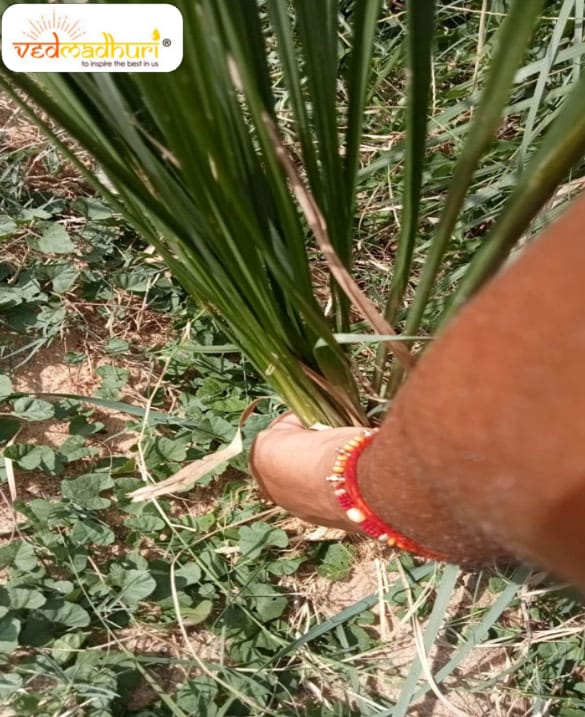
Abstract: The day prior to lunar conjunction in the Bhadrapada month (August-September) is celebrated as Kushotpatini Amavasya ( कुशोत्पाटिनी अमावस्या kuzotpATinI amAvasyA). The name is an articulation of kusha (कुश, a sacred grass) and utpatana (उत्पाटन= eradication) and it signifies uprooting the grass and collecting its long and pointed blades, which are to be used in various Vedic rites and rituals round the year. Besides its religious importance, the tradition is deeply rooted in ancient Vedic wisdom which promoted harmony with nature and a spirit of converting threats into opportunity. The invasive nature of kusha grass poses a serious threat to agriculture, especially paddy cultivation. However, some extraordinary characteristics of the grass make it a useful and sacred object. The festival is actually an environmental friendly strategy of weed management.
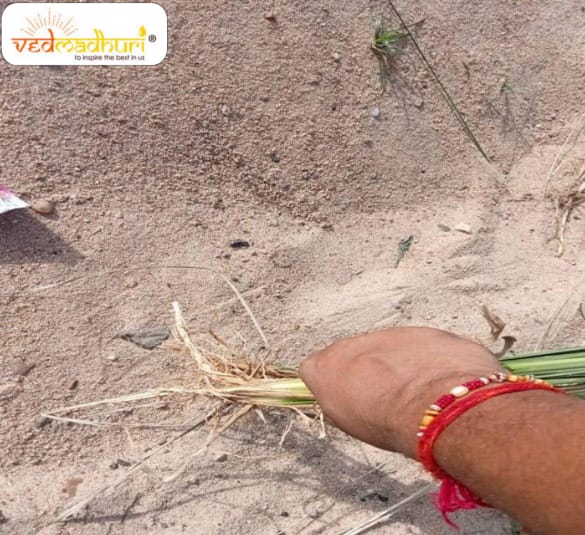
Kusha, also known as Darbha (दर्भ) represents several populations of grass that grow abundantly in almost all regions of India. Scientifically called Desmostachya bipinnata, one popular variety of kusha is the halfa grass of West Asia and North Africa. Kusha has a universal presence in wastelands that are subject to periodic disturbances such as cutting, grazing and burning. Besides abandoned agricultural fields it grows at the margins of field under-cultivation with wheat, cotton, sorghum, rice and sugarcane. From sand dunes to forests, inland brackish wetlands and marshes to the sea coast and deserts to the hilly tracts, Kusha is found everywhere.
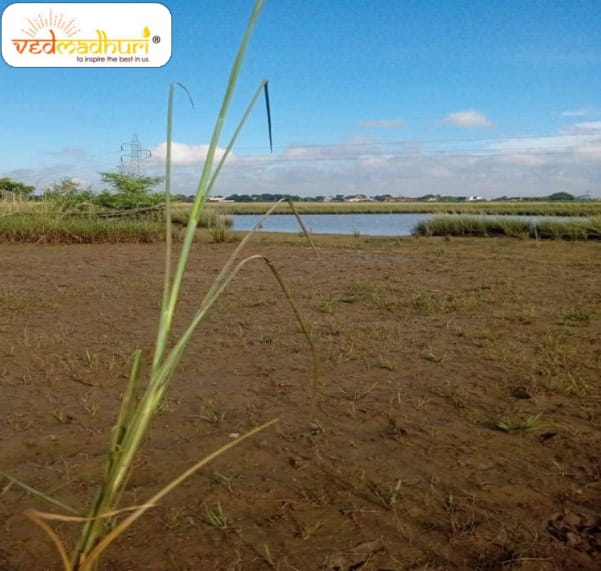
Our ancient seers (Rishis) believed what they saw with their amazing psycho-mental-spiritual constitution. They observed the long blades of grass with pointed ends, sometimes piercing their feet as they traversed through forest tracts or when they visited fallow fields to collect fallen grains for self-sustenance as a part of austerities. Instead of taking its nuisance in, they admired the sharpness of the kushankura (blades of kusha grass) and coined the word ‘kushagra’ to mean extraordinary intelligence. The universal presence of Kusha prompted them to coin another word, kushala, which they used for being ‘competent and fit for.’ The concept of happiness and well-being in Vedic times was to ensure physical, mental and spiritual thriving. The kusha, with its hardy nature due to deep and extensive roots became a living symbol of thriving and thus, ‘kushalam te’ (hail to thee) became a salutation and ‘kushal-prashna’ ( to ask after another’s welfare) substituted for the how do you do in the Vedic Sanatana Dharma!
The ancients also discovered the extraordinary mechanical strength of the Kusha fibre, once the grass was dried; it had a long shelf life. They thatched the roof of their cottages with it. They made ropes of the kusha (kusha-rajju) and even used it as the garment for the ascetic, which was called a kusha-cheera, what Rama and Laxmana had used during their exile (Ramayana II. 37.10). The Atharva Veda has some hymns in book 19, namely the दर्भ मणि सूक्त (Darbha-Mani Sukta), which eulogized body shields and armour made from the kusha: यत् ते दर्भ जरामृत्युः शतं वर्मसु वर्म ते। तेनेमं वर्मिणं कृत्वा सपत्नाञ्जहि वीर्यैः।। (Oh Dharba! hundreds are your shields and thousands are the means of strength and power. All the learned scholars have given you to the king for protection till old age or for long life”– Atharva Veda Book 19, Hymn 30.1).
Another important insight into the characteristics of kusha or darbha grass was its resilience to insects, worms and microbes. That prompted the sages to use the various species of these grasses in various purification rituals. Sage Agastya praised the endurance of these grasses in the hymn 191 of the first book of RgVeda: शरासः कुशरासो दर्भासः सैर्या उत। मौञ्जा अदृष्टा वैरिणाः सर्वे साकं न्यलिप्सत।। ( Reeds, halfa grass and the tufts thereof, along with Saccharum munja, etc.are associated with invisible organisms which may cause disease in man—RV 1.191.3). The sages also observed that Kusha (D. bipinnata) flourishes well in dry and hot conditions. Kusha often forms dense tufts producing a dominating patch of plants. Hence they gave it the name darbha: Shatapatha Brahmana says inasmuch as they rose forming bushes (dribh), they are (called) darbha-grasses. These darbha-grasses, then, are the water (which remained) pure, and meet for sacrifice (SB 7:2:3:2). The English word tuft is etymologically related to Sanskrita darbha.
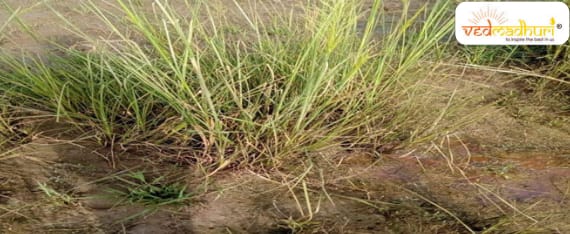
Since the times of Brahmana books, kusha blades were ritualistically used to sweep sacrificial ground. Shatapatha Brahmana commands the yajmana to place a bunch of Dharba grass (Kusa) on the middle of the altar site (SB —7-2-3-1) and the use of kush casks for filtering water and soma is prescribed in the yaJja rituals: “Whence spring these grasses of which the strainers are made; for they represent the water which was not putrified…‘Stalks of Kusa grass, for these are pure, and sacrificially clean……….. for the top is sacred to the gods (SB 7-3-2-3).
The pointed ends and tough but smooth fibres of kusha grass make it difficult for the crawling insects to pierce through a mat of kusha (kushasana). The Gita and other scriptures consider kusha mats ideal for meditation and anushthanas. For example:
शुचौ देश प्रतिष्ठाप्य स्थिरमासनमात्सनः । नात्युच्छ्रितं नातिनीचं चैलाजिनकुशोत्तरम्।। ( “Be seated on a kusha-mat, with successive covering of deer skin and clothes, and which is spread over a clean ground and neither too high, nor too low”–Gita VI.11)
कुशासने मन्त्रसिद्धिर्नात्रकार्य्या विचारणा। (“ The mat of kusha is a definite guarantee for attainment of the mantras”–Brahmanda-Purana)
भूमौ दर्भासने रम्ये सर्वदोषविवर्जिते। (“ the kusha-mat on the ground is considered to be free from all deficiencies—Amritopanishada)
Buddhism believes that Buddha attained realization while meditating on a kushasana and the Jains use it in various ceremonies.
A ring called kushangureeya or pavitree is made using kusha, which is worn in the ring finger and used in sanctification ritual during the performance of various rites. Both the kushasana and the pavitree are essential tools from Satapatha Brahmana period to this day.
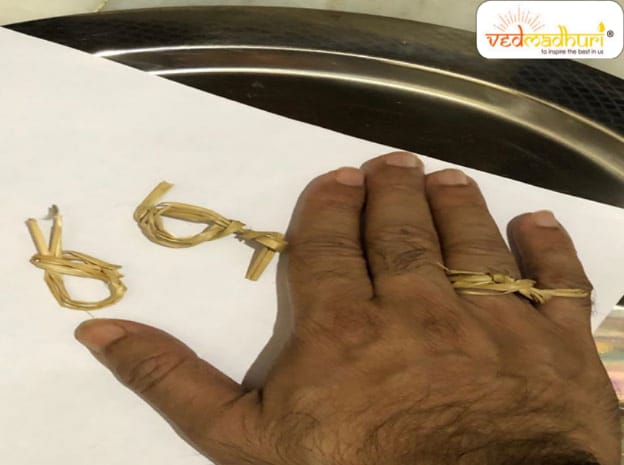
Another common belief in the anti-microbial properties of kusha yielded its use for preserving milk, curds, etc. during an eclipse. Kusha enjoys the status of medicine in Ayurveda, especially in the South. In a research undertaken at SASTRA University, Thanjavur, antibacterial properties of kusha or darbha were shown to be significant. The nano-patterns and microstructures in darbha grass attracted enormous number of bacteria into the hierarchical surface features. It delayed fermentation of cow’s milk into curd. (Article: “ Darbha grass, a natural preservative; published in the Hindu dated 16.03.2015).
Environmental Impact: After a period of senescence during winter months from Kartik to Magha (November to February), it is followed by a spurt of growth in summer months due to regeneration of shoots from the perennial rhizomes. Flowering and fruiting occurs from May to July, maturing from August to October. On moderately alkaline calcareous soils, the monsoon rains trigger active growth of in June and plant biomass attains a peak during the rainy season in September. Even the Vedic sages knew about this fact as evident from Atharva Veda hymn: यत् समुद्रो अभ्यक्रन्दत् पर्जन्यो विद्युता सह। ततो हिरण्ययो बिन्दुस्ततो दर्भो अजायत।। AV19.30.5 And, this is precisely the time when the festival of Kushotpatini Amavasya is observed. Kusha or Darbha (D. bipinnata) is one of the hardiest and most aggressive weeds in agricultural fields growing either with the crop or on field margins. It is very difficult to manage or eradicate established populations because of the extensive and deep rhizomatous root system. Infestations of D. bipinnata in the agricultural fields need to be removed by using appropriate mechanical and cultural techniques. Uprooting the grass at the time of Bhadrapada Amavasya is an appropriate technique to control the spread of seeds, root slips and rhizomes of Kusha grass as contaminants of crop seeds such as lentils, rice and sorghum which begin to undergo seed formation in September. It leaves the field free from this invasive and hardy weed even after paddy is harvested and wheat is sown. Indeed, without herbicides, this exercise of voluntary labour at a mass scale in India, as a ritual of Kushotpatini Amavasya, is a major and cost-effective tool for weed management. Nevertheless, the overuse of synthetic chemicals for weed control worsens the quality of soil, water, other life support systems, human health and food and development of herbicide-resistant ecotypes of weeds are detrimental to agricultural production.


